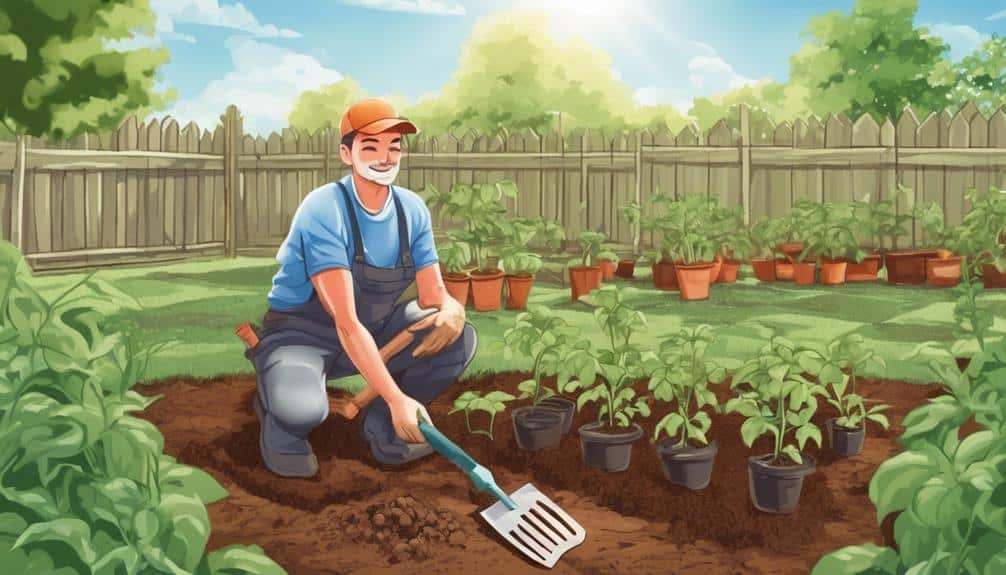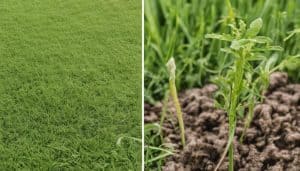To plant tomatoes in the ground, prioritize a location with at least 6-8 hours of direct sunlight and well-draining soil. Prepare the soil by testing and amending the pH, enriching it with compost or manure, and clearing weeds and debris. Choose healthy tomato plants with thick stems and dark green leaves, and inspect the root system for well-developed roots. Plant the tomato deep, covering the stem area to promote additional root growth. Provide sturdy support and water directly to the roots. With these basics covered, you're off to a strong start – and there's still more to discover about growing a thriving tomato crop.
Key Takeaways
• Choose a location with at least 6-8 hours of direct sunlight and well-draining soil to prevent waterlogging.
• Prepare the soil by testing and amending the pH, adding compost or manure, and clearing weeds and debris.
• Select healthy tomato plants with thick stems, dark green leaves, and no signs of pests or diseases.
• Plant tomatoes deep, covering the stem area, to encourage faster and deeper root growth and stronger plants.
• Provide sturdy support with tomato cages or stakes to prevent bending, improve air circulation, and keep fruit off the ground.
Choosing the Right Location
When selecting a spot to plant your tomatoes, prioritize a location that receives at least 6-8 hours of direct sunlight daily, as this will greatly impact the health and productivity of your tomato plants. Adequate sunlight is essential for best growth and fruit production.
Next, consider the soil quality and drainage in your chosen location. Well-drained soil is vital to prevent waterlogged soil, which can lead to root rot and other issues. If your ground soil is poor or lacks proper drainage, consider planting tomatoes in raised beds or containers.
Moreover, make sure you have enough space to plant your tomatoes at least 2 feet apart to prevent overcrowding and promote air circulation. This will help prevent disease spread and promote healthy growth.
Avoid areas prone to flooding or waterlogging, as excess water can lead to root rot and other issues in tomato plants. By choosing the right location, you'll set yourself up for success and be on your way to growing delicious, healthy tomatoes.
Preparing the Soil

Before planting your tomatoes, take the crucial step of preparing the soil, as it lays the foundation for a healthy and productive harvest. Tomatoes thrive in well-draining, fertile soil with a pH between 5.8 and 7. To guarantee ideal growing conditions, test your soil pH and amend it if necessary.
Next, enrich your soil by mixing in compost or well-rotted manure. This will enhance nutrient content, drainage, and the overall structure of your soil. Clear the planting area of weeds and debris to provide a clean environment for your tomato plants to grow. Consider creating raised beds or mounds, especially in cooler climates, to improve drainage and warm the soil.
For deeper soil preparation, consider using black plastic mulch to warm the soil, suppress weeds, and conserve moisture. This is particularly beneficial for indeterminate tomato plants, which grow deep into the soil.
Selecting Healthy Tomato Plants
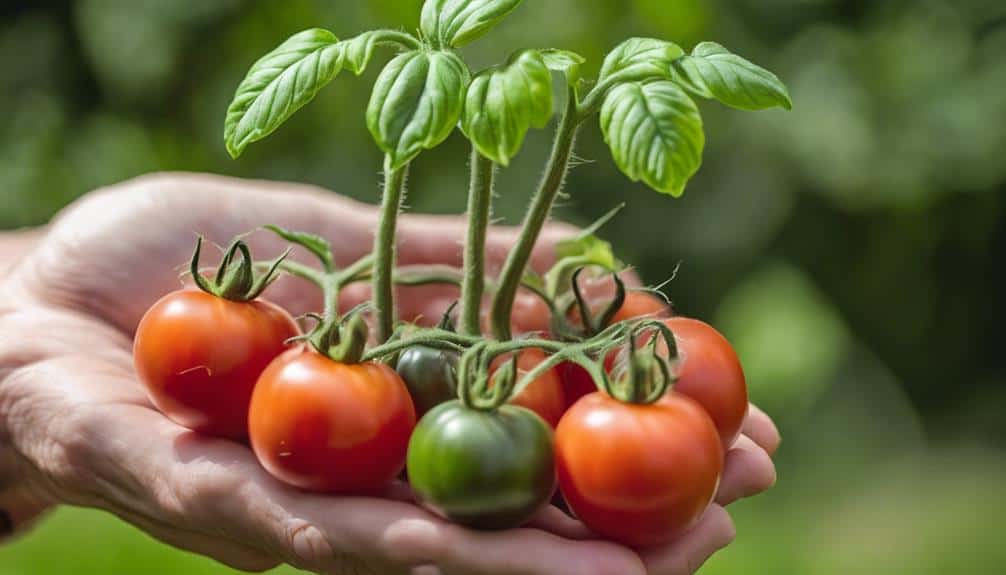
Select robust tomato plants that meet specific criteria to give your harvest a strong start. When choosing healthy tomato plants, look for ones that are at least 6-8 inches tall with thick stems and dark green leaves, indicating ideal growth potential. Make sure the plants are free of pests, diseases, or yellowing leaves, which can hinder their growth in the ground. Consider selecting varieties that are suitable for your region's climate and opt for disease-resistant options to promote better plant longevity.
Inspect the root system of the tomato plant to make sure it's well-developed and not root-bound before transplanting. A well-developed root system will enable the plant to absorb nutrients efficiently, leading to a bountiful harvest. Purchase tomato plants from reputable nurseries or garden centers that take proper care of their plants, increasing the chances of successful transplanting.
Planting Tomato Plants Deep
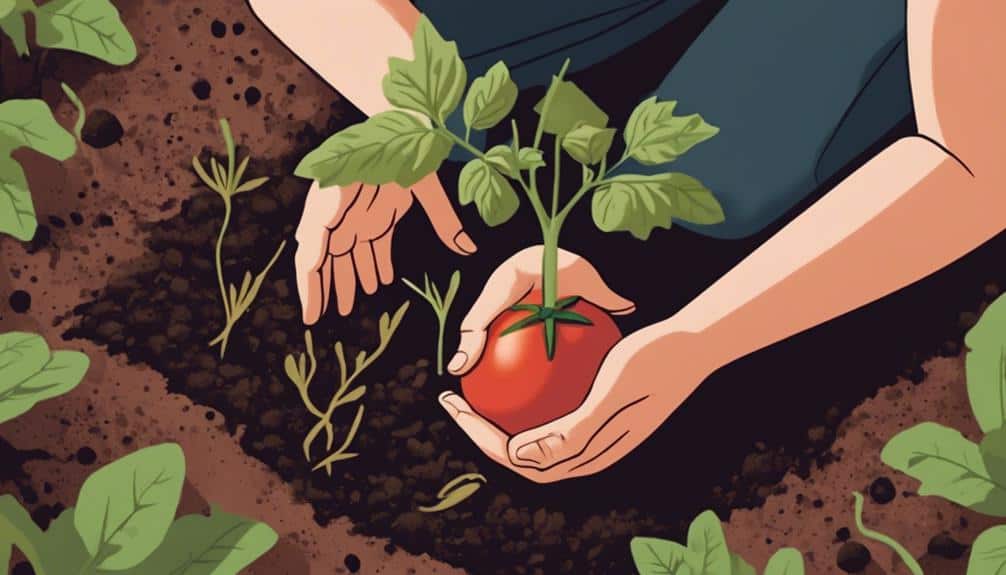
When you plant tomato plants deep, you're giving them a strong foundation for growth.
By covering the stem area with soil, you're encouraging roots to develop faster and grow deeper, which means your plants will be more resilient and productive.
This approach has several key benefits that will take your tomato gardening to the next level.
Roots Grow Deeper Faster
By planting tomato plants deeper in the ground, you encourage their roots to grow faster and deeper, ultimately leading to a stronger root system. This deeper planting allows for better nutrient uptake, stability, and improved resilience to weather fluctuations. Deeper roots also help plants access water and nutrients in the soil more effectively, making them more productive.
Here's a breakdown of the benefits of deep planting:
| Benefits | Description |
|---|---|
| Stronger Roots | Deeper roots lead to a stronger root system, supporting better nutrient uptake. |
| Stability | Deeper planting improves stability, reducing the risk of plants toppling over. |
| Weather Resilience | Tomato plants are more resilient to weather fluctuations, such as strong winds and heavy rainfall. |
| Nutrient Access | Deeper roots allow plants to access water and nutrients in the soil more effectively, promoting healthy growth. |
Soil Covers Stem Area
As you plant tomato plants deep in the ground, the soil covers the stem area, which promotes additional root growth, providing support and stability to the plant. This technique is especially beneficial for indeterminate varieties, which can become top-heavy and prone to damage.
By burying the stem deep, you're allowing the plant to develop roots along the buried stem, enhancing nutrient absorption and water uptake. This, in turn, leads to healthier, more productive tomato plants with increased fruit yield.
Planting tomatoes deep in the ground also helps prevent the plants from becoming top-heavy and improves their resilience to wind. As the roots grow deeper and stronger, they'll anchor the plant firmly in the soil, reducing the risk of damage from strong gusts.
More Roots Develop Faster
You'll be amazed at how quickly more roots develop when you plant tomato plants deeper in the ground, which ultimately leads to a stronger, more resilient plant. This deep planting technique encourages roots to grow faster, providing increased stability and nutrient uptake.
As a result, your tomato plants will thrive, even in hot weather conditions.
Here are the benefits of deep planting tomato plants:
- Increased root growth: More roots develop faster, providing additional support for the plant and leading to more bountiful harvests.
- Robust foundation: Deep planting helps tomatoes establish a strong foundation for growth and resilience to hot weather conditions.
- Optimal root development: Planting deep promotes stronger root systems, aiding in better fruit production and plant survival.
- Better nutrient uptake: Deeper roots allow for more efficient nutrient uptake, supporting healthy plant growth.
- Stronger plants: Deep planting leads to stronger, more resilient plants that can withstand challenging weather conditions.
Supporting Tomato Plants
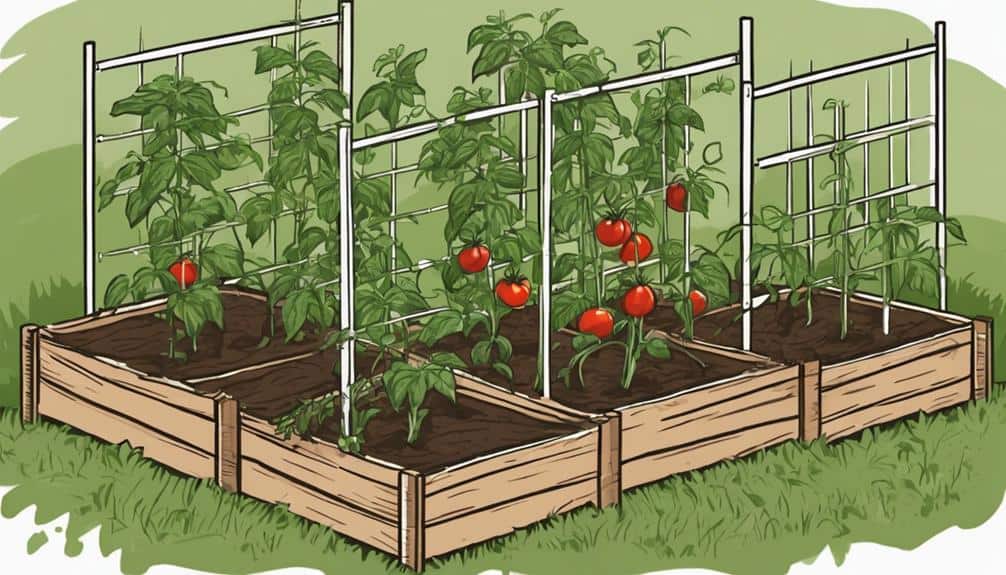
Providing sturdy support for your tomato plants is essential to promote healthy growth and maximize yields. As your plants grow, they'll need something to lean on to prevent them from sprawling on the ground. You can use a tomato cage or stake to provide the necessary support. Make sure the support is sturdy and tall enough to accommodate the plant's height as it grows.
Regularly tie the main stem to the support structure to prevent bending or breakage. This will also help improve air circulation around the plant, reducing the risk of diseases. Proper support also makes harvesting easier and keeps the fruit off the ground, reducing spoilage. You can use stakes or cages to provide the necessary support, depending on the variety of tomato plant you're growing.
Staking or caging your tomato plants will also help prevent diseases by improving air circulation and keeping the fruit off the ground. This is especially important for indeterminate varieties that will continue to grow and produce fruit throughout the season. By providing the right support, you'll be able to enjoy a bountiful harvest and reduce the risk of disease and spoilage.
Watering and Mulching
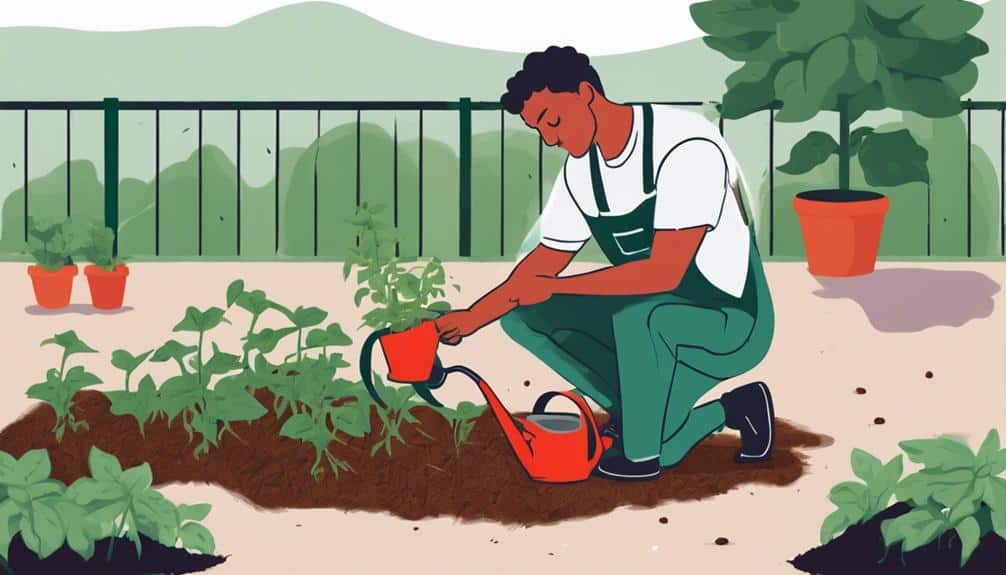
With your tomato plants securely staked or caged, it's time to focus on watering and mulching, the next critical steps in promoting healthy growth and maximizing yields.
Watering your tomato plants deeply is essential for their growth and fruit production. Aim to provide at least 1 inch of water per week, either through rainfall or irrigation. However, it's important to avoid overhead watering, which can lead to foliage diseases. Instead, water at the base of the plants to deliver water directly to the roots.
Mulching is another vital step in promoting healthy growth. Apply a 3-4 inch layer of organic material like straw or compost around the base of the plants. This will help retain moisture, suppress weeds, and regulate soil temperature. Mulching also reduces water evaporation, maintains soil moisture levels, and prevents soil compaction around the plants.
Here are some key benefits of proper watering and mulching:
- Encourages healthy root development and fruit production
- Reduces water evaporation and soil compaction
- Suppresses weeds and regulates soil temperature
- Maintains ideal soil moisture levels for fruit set
- Prevents foliage diseases and promotes overall plant health
Fertilizing Tomato Plants

Now that your tomato plants are securely staked or caged, and you've mastered the art of watering and mulching, it's important to feed them with a balanced fertilizer to promote vigorous growth and fruit production.
When fertilizing tomato plants, it's crucial to use a balanced fertilizer with an NPK ratio of 10-10-10. This guarantees your plants receive the necessary nutrients for healthy growth and fruit production. Apply fertilizer when planting tomatoes and again when the first fruit appears. Avoid over-fertilizing, as it can lead to excessive foliage growth at the expense of fruit production.
Here's a summary of the key fertilizing tips:
| Fertilizing Tips | When to Fertilize | Why |
|---|---|---|
| Use a balanced fertilizer (10-10-10) | At planting and first fruit appearance | Promotes healthy growth and fruit production |
| Avoid over-fertilizing | Always | Prevents excessive foliage growth |
| Water after fertilizing | Immediately after fertilizing | Helps nutrients reach roots effectively |
| Consider organic options | At planting and first fruit appearance | Provides a natural approach to feeding tomato plants |
| Use organic fertilizers like compost or fish emulsion | At planting and first fruit appearance | A natural alternative to synthetic fertilizers |
Common Tomato Pests and Diseases

As you nurture your tomato plants, you'll need to be on the lookout for common pests and diseases that can quickly destroy your crop. Tomato hornworms, aphids, and whiteflies are just a few pests that can damage your plants and reduce fruit production.
Meanwhile, diseases like early blight, late blight, and blossom end rot can cause wilting, yellowing leaves, and rotting fruit.
To protect your plants, it's essential to monitor them regularly for signs of disease or pest infestations. Keep an eye out for leaf spots, wilting, or unusual growth, and take action quickly if you notice any issues.
Here are some key things to keep in mind:
- Regularly inspect your plants for signs of pests or disease
- Use organic pest control methods like neem oil to prevent infestations
- Implement good cultural practices like proper spacing, adequate airflow, and mulching to reduce the risk of pests and diseases
- Keep your garden clean, removing any debris or weeds that can harbor pests
- Be prepared to take action quickly if you notice any problems, to prevent them from spreading and causing more damage
Caring for Maturing Tomato Plants
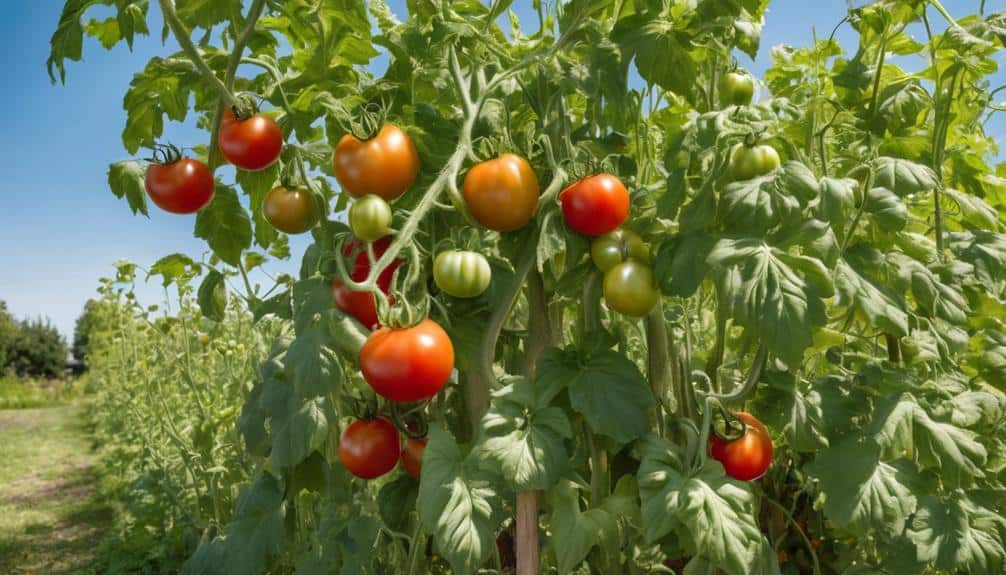
As your tomato plants grow, you'll need to focus on providing the right conditions for them to thrive. You'll want to make sure they receive the right amount of water and mulch to retain moisture and suppress weeds.
Now that your plants are maturing, it's time to fine-tune your care routine, including pruning techniques, and staying vigilant for pests and diseases.
Water and Mulch Needs
To guarantee ideal growth and fruit production, you should provide your maturing tomato plants with consistent moisture and adequate mulching. Watering your tomatoes well is essential, as it directly affects fruit development. Aim to provide about 1 inch of water per week, either from rainfall or irrigation. However, be cautious not to overwater, as this can lead to root rot.
Here are some essential tips to keep in mind:
- Monitor soil moisture levels to avoid overwatering and underwatering.
- Adjust your watering frequency based on weather conditions, increasing during hot and dry periods.
- Mulch around your tomato plants with a 3-4 inch layer to retain soil moisture, suppress weeds, and prevent diseases.
- Mulching helps regulate soil temperature, reduce evaporation, and protect tomato roots from extreme temperature fluctuations.
- Keep an eye on your plants' response to watering and mulching, making adjustments as needed to ensure ideal growth and fruit production.
Tomato Pruning Techniques
You'll need to prune your maturing tomato plants regularly to promote healthy growth and fruit production. Pruning is essential to enhance airflow, reduce disease risk, and support plant health. To prune your tomato plants effectively, follow these techniques:
| Pruning Technique | Why Prune | Benefits |
|---|---|---|
| Remove lower leaves | Enhance airflow, reduce disease risk | Improves plant health, promotes vertical growth |
| Trim off suckers | Direct energy to fruit development | Supports fruit production, enhances yield |
| Remove yellowing/diseased leaves | Prevent disease spread, maintain plant health | Reduces disease risk, promotes healthy growth |
| Use clean, sharp pruning shears | Prevent disease spread | Ensures clean cuts, reduces risk of infection |
Pest and Disease Control
Now that your tomato plants are pruned and thriving, it's time to focus on protecting them from pests and diseases that can quickly destroy your harvest. As your plants mature, it's crucial to monitor pests, inspect diseases, and take proactive measures to guarantee plant health.
Here are some key strategies to keep in mind:
- Monitor tomato plants for common pests like aphids, hornworms, and whiteflies to address issues promptly.
- Use organic pest control methods such as insecticidal soap or neem oil to protect maturing tomato plants.
- Inspect your plants regularly for signs of diseases like blight or leaf spot and take necessary measures for plant health.
- Prune lower leaves of tomato plants to enhance air circulation, reducing the risk of fungal diseases.
- Implement proper watering practices and mulching to prevent soil-borne diseases and maintain plant vigor.
Harvesting Ripe Tomatoes
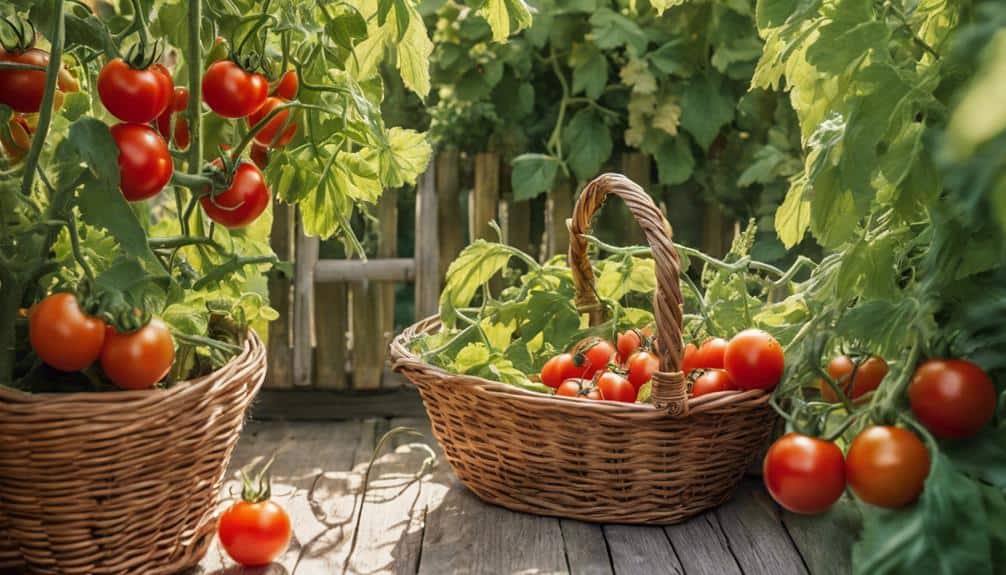
Your tomatoes are finally ready to be picked when they've reached their full, vibrant color and exhibit a slight give when squeezed. This is the perfect time to harvest them, as they're now fully ripe and ready to be enjoyed. But how do you know for sure? Here are the signs of ripeness to look out for:
| Sign of Ripeness | Description | What to Do |
|---|---|---|
| Vibrant Color | Tomatoes have reached their full color | Harvest time! |
| Slight Give | Tomatoes are slightly soft to the touch | Harvest time! |
| Easy Removal | Tomatoes come off the vine easily | Harvest time! |
When harvesting, gently twist or cut the tomatoes from the vine to avoid damaging the plant. Avoid picking tomatoes when they're still green and hard, as they won't ripen off the vine. Once harvested, store your ripe tomatoes at room temperature, away from direct sunlight, to maintain their flavor and texture. This will ensure your tomatoes stay fresh and delicious for a longer period. By following these simple tips, you'll be enjoying your freshly harvested ripe tomatoes in no time!
Is There a Legal Process for Planting Tomatoes in the Ground?
There is no legal process for planting tomatoes in the ground. However, if you believe you have faced a wrongful arrest lawsuit value estimation, it is important to seek legal advice. It is crucial to understand your rights and explore possible legal actions in such a scenario.
Frequently Asked Questions
What Is the Correct Way to Plant Tomato Plants?
You're wondering what's the correct way to plant tomato plants?
Well, here's the deal! When planting, dig a hole 2/3 the height of the plant, snip off lower branches, and place it in the hole or trench.
Cover it with soil, leaving only the top few inches exposed. This guarantees ideal root growth, stability, and nutrient uptake for healthy plants.
Don't forget to label each variety for easy identification!
How Deep Do You Plant Tomato Plants in the Ground?
You're wondering how deep to plant tomato plants in the ground. The answer is: bury them up to 2/3 of their height. This encourages the growth of additional roots, providing better support for the plant and increased fruit production.
What to Put in the Hole When You Plant Tomatoes?
As you dig into the earth, imagine your tomato plant's roots spreading like enthusiastic arms, embracing the nourishment you're about to provide.
When planting, add a handful of compost or manure, a sprinkle of balanced fertilizer, and a pinch of Epsom salt to the hole.
Mix in a teaspoon of bone meal or crushed eggshells to prevent blossom-end rot.
Water the hole, and you'll be giving your tomato plant the perfect start.
How Do You Grow Tomatoes Along the Ground?
You're looking to grow tomatoes along the ground?
Start by choosing a sunny spot with well-drained soil and enough space for your plants to spread out.
Then, plant your seedlings deep, burying the stem up to the first set of leaves.
Provide support with stakes, cages, or a trellis, and water consistently to guarantee healthy growth and fruit production.
Mulch around your plants to retain moisture and suppress weeds.
With these steps, you'll be enjoying fresh, delicious tomatoes in no time!
Conclusion
As you stand back to admire your handiwork, the freshly planted tomato seedlings stretch towards the sun like outstretched arms, embracing the warmth and light.
The earthy scent of soil and the promise of juicy red fruits to come fill the air.
Your labor of love is now a thriving garden, nourished by your care and attention.
With each passing day, your tomatoes will grow, flourish, and ripen, a proof to the fruitful rewards of your hard work.
